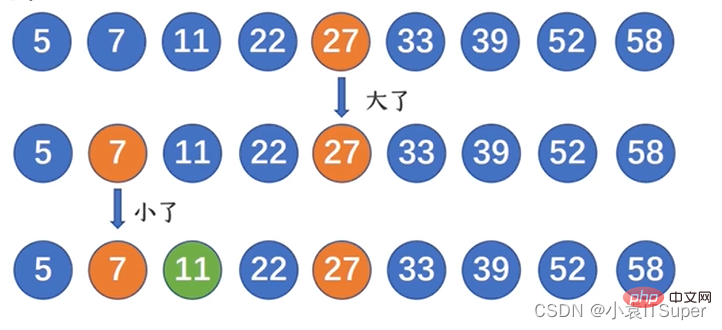Python detailed analysis of binary search algorithm
This article brings you relevant knowledge about python, which mainly organizes issues related to the binary search algorithm, including algorithm description, algorithm analysis, algorithm ideas, etc. The following is Let's take a look, hope it helps everyone.

Recommended learning: python video tutorial
1. Algorithm description
The dichotomy is one A relatively efficient search method
Recall the number-guessing mini-game that you have played before. A positive integer x less than 100 is given in advance, and you will be given prompts to judge the size during the guessing process, and ask you how Guess it quickly?
The game we played before gave 10 chances. If we learn the binary search method, no matter what the number is, it only takes 7 times at most to guess the number.
2. Algorithm analysis
1. It must be an ordered sequence.
2. There are requirements for the amount of data.
The amount of data is too small and not suitable for binary search. Compared with direct traversal, the efficiency improvement is not obvious.
It is not suitable to use binary search if the amount of data is too large, because arrays require continuous storage space. If the amount of data is too large, continuous memory space to store such large-scale data is often not found. .
3. Algorithm idea
Suppose there is an ordered list as follows:
Is the number 11 In this list, what is its index value?
4. Code implementation
Pure algorithm implementation
Implementation code :
arr_list = [5, 7, 11, 22, 27, 33, 39, 52, 58]# 需要查找的数字seek_number = 11# 保存一共查找了几次count = 0# 列表左侧索引left = 0# 列表右侧索引right = len(arr_list) - 1# 当左侧索引小于等于右侧索引时while left arr_list[middle]:
# 左侧索引为中间位置索引+1
left = middle + 1
# 如果查找的数字小于中间位置的数字时
elif seek_number <p>Run result:</p><p><img src="/static/imghw/default1.png" data-src="https://img.php.cn/upload/article/000/000/067/ab7ca007166584d2196443b3030f239a-4.png" class="lazy" alt="Python detailed analysis of binary search algorithm"></p><h2 id="Recursive-method-implementation">Recursive method implementation</h2><blockquote><p>A variable count is defined in the loop. If the first The count does not change after the loop, which means that the input is an ordered sequence. At this time, we directly return to exit the loop. The time complexity at this time is O(n)</p></blockquote><p>Implementation code: </p> <pre class="brush:php;toolbar:false">arr_list = [5, 7, 11, 22, 27, 33, 39, 52, 58]def binary_search(seek_number, left, right):
if left arr_list[middle]:
left = middle + 1
else:
return middle # 进行递归调用
return binary_search(seek_number, left, right)
# 当左侧索引大于右侧索引时,说明没有找到
else:
return -1# 查找的数字seek_number = 11# 列表左侧索引left = 0# 列表右侧索引right = len(arr_list) - 1print("查找的数字:%s,索引为:%s" % (seek_number, binary_search(seek_number, left, right)))Running results:

Recommended learning:python video tutorial
The above is the detailed content of Python detailed analysis of binary search algorithm. For more information, please follow other related articles on the PHP Chinese website!

Hot AI Tools

Undresser.AI Undress
AI-powered app for creating realistic nude photos

AI Clothes Remover
Online AI tool for removing clothes from photos.

Undress AI Tool
Undress images for free

Clothoff.io
AI clothes remover

Video Face Swap
Swap faces in any video effortlessly with our completely free AI face swap tool!

Hot Article

Hot Tools

Notepad++7.3.1
Easy-to-use and free code editor

SublimeText3 Chinese version
Chinese version, very easy to use

Zend Studio 13.0.1
Powerful PHP integrated development environment

Dreamweaver CS6
Visual web development tools

SublimeText3 Mac version
God-level code editing software (SublimeText3)

Hot Topics
 1387
1387
 52
52
 Is the vscode extension malicious?
Apr 15, 2025 pm 07:57 PM
Is the vscode extension malicious?
Apr 15, 2025 pm 07:57 PM
VS Code extensions pose malicious risks, such as hiding malicious code, exploiting vulnerabilities, and masturbating as legitimate extensions. Methods to identify malicious extensions include: checking publishers, reading comments, checking code, and installing with caution. Security measures also include: security awareness, good habits, regular updates and antivirus software.
 How to run programs in terminal vscode
Apr 15, 2025 pm 06:42 PM
How to run programs in terminal vscode
Apr 15, 2025 pm 06:42 PM
In VS Code, you can run the program in the terminal through the following steps: Prepare the code and open the integrated terminal to ensure that the code directory is consistent with the terminal working directory. Select the run command according to the programming language (such as Python's python your_file_name.py) to check whether it runs successfully and resolve errors. Use the debugger to improve debugging efficiency.
 Can vs code run in Windows 8
Apr 15, 2025 pm 07:24 PM
Can vs code run in Windows 8
Apr 15, 2025 pm 07:24 PM
VS Code can run on Windows 8, but the experience may not be great. First make sure the system has been updated to the latest patch, then download the VS Code installation package that matches the system architecture and install it as prompted. After installation, be aware that some extensions may be incompatible with Windows 8 and need to look for alternative extensions or use newer Windows systems in a virtual machine. Install the necessary extensions to check whether they work properly. Although VS Code is feasible on Windows 8, it is recommended to upgrade to a newer Windows system for a better development experience and security.
 Can visual studio code be used in python
Apr 15, 2025 pm 08:18 PM
Can visual studio code be used in python
Apr 15, 2025 pm 08:18 PM
VS Code can be used to write Python and provides many features that make it an ideal tool for developing Python applications. It allows users to: install Python extensions to get functions such as code completion, syntax highlighting, and debugging. Use the debugger to track code step by step, find and fix errors. Integrate Git for version control. Use code formatting tools to maintain code consistency. Use the Linting tool to spot potential problems ahead of time.
 Choosing Between PHP and Python: A Guide
Apr 18, 2025 am 12:24 AM
Choosing Between PHP and Python: A Guide
Apr 18, 2025 am 12:24 AM
PHP is suitable for web development and rapid prototyping, and Python is suitable for data science and machine learning. 1.PHP is used for dynamic web development, with simple syntax and suitable for rapid development. 2. Python has concise syntax, is suitable for multiple fields, and has a strong library ecosystem.
 Can vscode be used for mac
Apr 15, 2025 pm 07:36 PM
Can vscode be used for mac
Apr 15, 2025 pm 07:36 PM
VS Code is available on Mac. It has powerful extensions, Git integration, terminal and debugger, and also offers a wealth of setup options. However, for particularly large projects or highly professional development, VS Code may have performance or functional limitations.
 PHP and Python: Different Paradigms Explained
Apr 18, 2025 am 12:26 AM
PHP and Python: Different Paradigms Explained
Apr 18, 2025 am 12:26 AM
PHP is mainly procedural programming, but also supports object-oriented programming (OOP); Python supports a variety of paradigms, including OOP, functional and procedural programming. PHP is suitable for web development, and Python is suitable for a variety of applications such as data analysis and machine learning.
 Can vscode run ipynb
Apr 15, 2025 pm 07:30 PM
Can vscode run ipynb
Apr 15, 2025 pm 07:30 PM
The key to running Jupyter Notebook in VS Code is to ensure that the Python environment is properly configured, understand that the code execution order is consistent with the cell order, and be aware of large files or external libraries that may affect performance. The code completion and debugging functions provided by VS Code can greatly improve coding efficiency and reduce errors.







